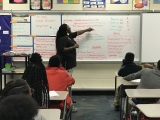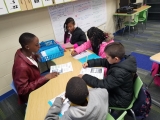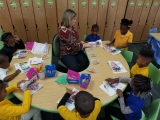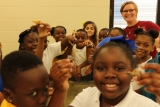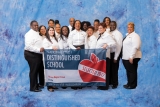-
Category 1
Selected in 2017
-
Grades: pre k - 8
School Setting: rural
Town Population: 1,800
Student Enrollment: 598
Student Demographics:
Black/African American: 78%
Teacher/Student Ratio: 1:20
White/Caucasian: 6%
Hispanic: 13%
Hawaiian/Pacific Islander: 0.5%
Asian: 0%
Native American: 0.5%
Other: 2%
% Reduced Lunch: 100%
% ELL Learners: 19.4%
Founded: 2015 -
PRINCIPAL:
Delshuana Jackson -
CONTACT:
1210 Kemp Road
Havana, FL 32333
850-662-2750
jacksond@gcpsmail.com
Havana Magnet School
Havana, FL
Ensuring that quality instruction is taking place in the classroom is our main priority for student academic improvement and performance.
- Describe specific programs in place to ensure that families are involved in the success of your school and students.
- After every grading period, we host a Parent Expo where parents are able to come out, receive report cards, and speak with teachers regarding their child’s progress. Each grade level hosts a curriculum night so that parents can see what a day in school is like for their child. The parents are allowed the time to work in small group settings, create anchor charts, participate in math speed drills, etc. They are able to ask questions about standards, assessments, and classroom routines and policies. Every month, we provide a monthly calendar that keeps parents abreast of events and activities. We host honor assemblies, holiday assemblies, pep rallies, and kickoff celebrations for various initiatives. With a parent liaison on campus, we are able to reach out to parents weekly to bridge the home-school connection.
- Describe the most successful activity your school has initiated to strengthen ties to your community.
- Our Extended School Week initiative has proven to be the most successful activity initiated by the school to strengthen ties to the community. For this program, local businesses and churches give donations, provide volunteer service, and mentor students in grades 3-8. We host Saturday School for 16 weeks prior to state assessment to better prepare students in the areas of English language arts, mathematics, and science. Students receive a breakfast and hot lunch, catered by community partners every Saturday. To defray the costs of Saturday School, we host a community breakfast to raise funds and kick off Saturday School. Community stakeholders are all a part of this endeavor.
- Describe your philosophy of school change or improvement.
- Working towards change is a difficult task; however, we are committed to continuous improvement in every area of the school. We strive to provide the best education possible to each and every student. Operational change and continuous school improvement require teamwork, dedication, and commitment. The initiatives put in place for school improvement force us to expand students’ thinking, unleash their potential, and nurture a love of inquiry. It is our job in seeking change to identify problems and embrace ideas that are meaningful to instruction. We must remember that to improve, we must sustain a perfect interface of encouragement and engagement.
- What are your school’s top two goals for the next year?
- For next year, our school’s top goals are to improve reading proficiency across all grade levels and increase parental engagement. Reading proficiency affects students’ learning experiences and school performance. Reading proficiency is important for the functionality in today’s society; therefore, continuously improving reading proficiency is a priority for the next school term. Another goal is to increase parental engagement. Parental engagement and support are essential in increasing a student’s opportunity to maximize their potential. Our goal is to increase parental engagement through volunteering, mentoring, and establishing school and community partnerships.
- What is the single most important factor in the success of your school that others could replicate?
- The most important factor in the success of our school that can be replicated is instructional leadership. Instructional leadership places a focus on improving teaching, learning, and high expectations. In our school, it is essential that administrators partner with teachers in the development and implementation of instruction. In our school, instructional leaders allocate and distribute resources, set clear and attainable goals, manage and develop curriculum, and place an emphasis on developing high quality teachers. Additionally, modeling, observing classrooms, and offering constructive feedback are requirements as an instructional leader. Ensuring that quality instruction is taking place in the classroom is our main priority for student academic improvement and performance.
- Describe the program or initiative that has had the greatest positive effect on student achievement, including closing achievement or opportunity gaps, if applicable.
- Acaletics is a program that is designed to assist students in excelling in mathematics, improving academic achievement, and closing achievement gaps. The mission is to have students use the same energy that athletes put into preparing for competition into their academic study. This program helped the school improve test scores by providing direct support to teachers and administrators, and also providing supplementary materials and other resources needed to implement the program. From the 2015-2016 school year to the 2016-2017 school year, student performance in mathematics improved significantly. Through the implementation of the Acaletics program, proficiency increased from 54% to 79%, learning gains increased from 58% to 82%, and the passing rate of the lowest quartile increased from 44% to 83%.
- Explain how Title I funds are used to support your improvement efforts.
- In order to help maintain and improve instructional effectiveness, Title I provides many resources in support of instruction. Title I funds are used to support improvement efforts in various ways. Title I funds are used to purchase technology to enhance instruction. In addition, Title I funds fund additional interventions and supplementals. Those programs are used to target individual student needs and provide differentiated instruction. We also use Title I funds to host professional learning webinars to enhance teachers’ skill sets and keep them abreast of leading edge instructional practices in their content areas. In order for instruction to be provided at its best, many resources are provided to support instruction and project-based learning opportunities.
- Identify the critical professional development activities you use to improve teaching and student learning.
- Because our instruction is standards-based, we offer many professional development opportunities and activities in which teachers participate regularly. Data is vital at our school; therefore, we offer and provide extensive training in data analysis and implementation in the classroom. Teachers are afforded the opportunity to learn how to use data to drive instruction, create differentiated instruction opportunities and activities for students, and maintain and increase proficiency in various subject areas. In an effort to improve student learning, anchor charts are essential in every classroom. Anchor charts enhance the print-rich environment and provide visuals that students and teachers are able to reference daily. Trainings and follow-up in-services are offered often to ensure the fidelity of the implementation of anchor charts in the classroom.
- Describe how data is used to improve student achievement and inform decision making.
- One of the highest priorities identified through planning is the need to deeply analyze data to inform decision making. The results are continuously used to identify student needs and evaluate instructional methods. Progress monitoring is conducted on a regular basis to revise and restructure instruction in order to meet the needs of struggling students. Student data is monitored formally each week through benchmark assessments in all content areas. The data is discussed via direct conversation with the teacher. As needed, the principal provides materials and resources based on individual student needs. In addition, interim assessments are administered at various intervals to ensure student mastery of the standards is sustained. Based on the results, instructional plans are revised to facilitate continuous improvement in the core academic areas.
- Describe your school culture and explain changes you’ve taken to improve it.
- The school is located in a rural area where many residents are economically disadvantaged. Many of our students have limited access to books and technology. Recognizing the needs of the students in and out of school, we’ve created a partnership with the county’s public library system to provide access to books and technology to foster a culture of and love for reading and learning. We’ve also implemented a rigorous curriculum which includes standards-based instruction, arts integration, and accelerated instruction. In addition, we have placed an emphasis on student motivation through incentives and celebrating student success.
Stats
-
Category 1
Selected in 2017
-
Grades: pre k - 8
School Setting: rural
Town Population: 1,800
Student Enrollment: 598
Student Demographics:
Black/African American: 78%
Teacher/Student Ratio: 1:20
White/Caucasian: 6%
Hispanic: 13%
Hawaiian/Pacific Islander: 0.5%
Asian: 0%
Native American: 0.5%
Other: 2%
% Reduced Lunch: 100%
% ELL Learners: 19.4%
Founded: 2015 -
PRINCIPAL:
Delshuana Jackson -
CONTACT:
1210 Kemp Road
Havana, FL 32333
850-662-2750
jacksond@gcpsmail.com



